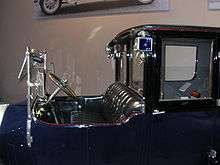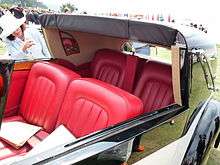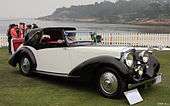Coupe de Ville
Coupe de Ville (North American, with silent "e" in "coupe") or coupé de ville is one of a large number of terms used to describe an automobile with an external or open-topped driver's position and an enclosed compartment for passengers. Among other names for this body style are sedanca, town car, victoria, and brougham.
Most versions are variations on one of two main types. In one, known as the town car in North America or, in continental Europe, as the coupé chauffeur as well as the coupé de ville, the driver is separated from a fully enclosed passenger compartment by a partition; in the other, the passenger compartment is without its own doors and is accessed from the front.
Origin
The unusual body dates to medieval Europe. In order to identify incoming guests at court as friendly, it was necessary for the host to be able to identify the livery of the visiting guests' coachman from a distance. To enable the coachman to be identifiable, he was hence placed high up and in the open.[1]
The term "coupé de ville" is known to be in use in the 19th century before the invention of the automobile. As a carriage, the coupé de ville was a variant of the coupé carriage that was nearly indistinguishable from the British clarence.[2]
Terminology
The term "de ville" is French for "for town"[3] and indicates that the vehicle is for use in town or for short distances. When added to the end of a body style (saloon, coupé, landaulet, etc.), "de Ville" indicated that the top over the driver's compartment could be folded away, retracted, or otherwise removed.[4] As a vehicle for town use, the coupé de ville usually had no facilities for carrying luggage.[5]
In North America, manufacturers have used the term liberally to the point where the terms "Sedanca" and "de Ville" have almost lost their distinction.[6]
Type I: "Town car"

One style of coupé de ville has rear doors to access the enclosed passenger section and a partition, similar to that in a limousine between the enclosed passengers and the open driver.[7] In the United States, this style is referred to as a "town car" or, earlier, a town brougham,[8][9] while, in northern Europe, the term "coupé de ville" is used for both this version and the two-door version described in the previous section.[7]
Type II: "Sedanca coupé"

Another style of coupé de ville has a fixed or folding roof over the rear seats and open front seats. Also known as a sedanca[10] or a sedanca coupé,[11] this version may or may not have had sliding or detachable roof panel for covering the front seats.[10] The French-derived term "coupé de ville" is also used for this two-door version without a divider between the driver and the passengers. In the United States, the similar term "coupe de ville" is used for this version.[12] A coupé de ville is alternatively defined in North America as a drophead coupé with a three-position top which may be fully closed, fully open, or partially closed, leaving rear passengers covered.[13]
Table
| Term | Type I ("Town car") locations | Type II ("Sedanca coupé") locations | Notes | Example |
|---|---|---|---|---|
| Brougham | United Kingdom United States | none | The term is derived from the brougham carriage. In strict terms, a brougham would have a sharply squared rear end of the roof and a forward-curving body line at the base of the front of the passenger enclosure. The term degraded during the twentieth century.[14] | Peugeot Type 27 |
| Cabriolet-Victoria | none | United Kingdom | Drophead coupé with three-position folding top: fully open, covering the rear passengers only, or fully closed.[11] This is the dictionary definition of a coupe de ville in the United States.[13] | |
| Coupé chauffeur | France | None | French variant of the coupé de ville with a small passenger compartment.[5] | Minerva AK-32 CV |
| Coupé de ville | France Germany Italy | United Kingdom United States | ||
| Coupé limousine | France | none | Similar to the coupé chauffeur but with a longer passenger compartment capable of holding up to seven passengers, with up to three on jump seats usually facing forward.[15] The style was referred to in the United States as a limousine town car and in Britain as a limousine de ville.[16] The term coupé Napoleon was also used on a Bugatti Royale body of the type. | Bugatti 41 Coupé Napoleon |
| Sedanca | Spain United Kingdom | United Kingdom | The terms sedanca and sedanca de ville were introduced by Spanish nobleman Count Carlos de Salamanca, the Spanish distributor for Rolls-Royce, in 1923.[11][17] By one account, sedanca de ville is type I in the UK while sedanca is type II but,[10] by another, sedanca de ville is a redundant term, sedanca is type I in the UK, and sedanca coupé is Type II.[11] The strict definition of a sedanca includes a locker for the cant rails and canopy that form the roof; this was introduced by Count de Salamanca in his original sedanca.[11] | |
| Sedanca coupé | none | United Kingdom | (see Sedanca above) | Bentley Gurney-Nutting sedanca coupé |
| Sedanca de Ville | United Kingdom | none | (see Sedanca above) | Rolls-Royce Phantom III Sedanca de Ville |
| Town car | United States | none | Anglicized version of "de Ville".[3] Town cars normally had side windows in the doors only.[18] | Cadillac 57 V8 |
Design form

From the early designs, where the driver was left fully open to the weather with no cover, no doors, and sometimes no windshield,[3] the design evolved with increases in both road speed and distances travelled. Windshields were added to protect the driver from dirt from the unpaved roads and dung from draught animals; doors to the driving compartment came later.
Early roofs for the front compartment were made of a single-skin of leather, with no structural support, held in place between the passenger compartment and the windshield by poppers to allow for easy removal or rollback when the weather allowed.[8] From the late 1920s onward designs used a metal two-skin roof which regressed into a void above the passenger compartment, either manually or electrically.[19]
The passenger compartment was normally luxurious,[8] clad in the best materials, with seating for between two and most often up to six or occasionally eight persons, made of the finest cotton or silk adorned with brocade. The same material was also most often used to provide complete curtain coverage for the compartment, and was matched by substantial carpet and fine inlaid woodwork. The drivers compartment had leather seats to be durable enough to endure the weather. The division between the two compartments often held jump seats for lighter passengers such as children, and it would often accommodate various compartments for drinks, cigars, make-up, or books.
The two compartments were separated by a divide, often with a small slide-back glass window, or latterly completely made of glass with a manual or electric winding system. The passengers could speak to the driver through a communications tube,[8] or, from the 1920s, through an electrical device similar to an telephone. Some designs included a switch panel in the rear passenger compartment, which contained a speedometer and switches to impart the most common instructions to the driver via a lighted dashboard panel, such as "stop", "left", "right", or "home".
Manufacturer
Europe
Due to its high-end luxurious form, bespoke commissioning and resultant design nature, and final high cost, coupés de ville of both types were hand-built in small numbers. The cars were almost always made as individual ("Full Custom"), or in a small edition with individual equipment ("semi-custom").
In France, Audineau et Cie., Mulbacher, and Rothschild became known for such works. Henri Binder built a Sedanca de Ville body for a Bugatti Royale.
In the United Kingdom, the style was applied to numerous chassis by the various specialist coachwork builders, but it is most often associated via the 4-door Sedanca de Ville variant with Rolls-Royce motor cars, and the 2-door sporting Sedanca variant with Bentleys. Coachbuilders included Barker, Hooper, H. J. Mulliner and Park Ward.
North America
Bespoke
Due to its historic and luxurious connections, the term found early favour amongst many North America automobile manufacturers. Manufacturers included Brewster & Co. (especially for Rolls-Royce, Packard and its own chassis), LeBaron and Rollston.
In 1922, Edsel Ford had a Lincoln built with a town car body for his father's personal use.[20]
Seeking publicity and building on his work with Studebaker, Raymond Loewy had two Lincoln Continentals altered to coupés de ville in 1946 using a removable plexiglas cover over the chauffeur.[21]
Production
Ford introduced a town car body to its Model A line in December 1928.[22] Designed by LeBaron and designated the 140-A,[23] the Model A town car was sold until early 1930.[24] 1,065 Model A town cars were built by the end of production in 1930.[25]
In 1940 and 1941, a limited edition model of the Cadillac Sixty Special carried the Town Car name. It was reintroduced as a coupe hardtop in 1949 using the French name for the body style Coupe DeVille and in 1956 as a four-door hardtop called the Sedan DeVille.
Present
Since World War II, few manufacturers have built cars with an open front. The part-open style became obsolete when high-speed highways entered the cities. The styles are now remembered in North America in the model names Cadillac Coupe de Ville and Lincoln Town Car, which derive their names from these historical body styles despite not carrying either a town car body or a coupé de ville body by the historical definitions.
See also
- Landaulet—the opposite with the rear convertible and the front closed. Landaulets de ville, or town landaulets, were similar to sedancas de ville but with folding tops on the passenger enclosure instead of fixed tops.
- Targa top also known in the United Kingdom as a Surrey Top.[26] Removable panel over the front seats, while the back of the top is usually fixed.
References
Citations
- ↑ Roßfeldt 1999.
- ↑ Stratton 1878, pp. 242–243.
- 1 2 3 Haajanen 2003, p. 60.
- ↑ Beattie 1977, p. 18.
- 1 2 Haajanen 2003, p. 55.
- ↑ Introduction – Coachbuilt 2004
- 1 2 Haajanen 2003, pp. 55–56.
- 1 2 3 4 Town car – Coachbuilt 2004
- ↑ Georgano 1971, p. 217.
- 1 2 3 Culshaw & Horrobin 2013, p. 483.
- 1 2 3 4 5 Haajanen 2003, p. 121.
- ↑ Coupe de Ville – Coachbuilt 2004
- 1 2 Gove 1966, p. 521.
- ↑ Haajanen 2003, pp. 24–27.
- ↑ Haajanen 2003, p. 57.
- ↑ Haajanen 2003, p. 58.
- ↑ Beattie 1977, p. 57.
- ↑ Haajanen 2003, p. 148.
- ↑ de Ville extension – Coachbuilt 2004
- ↑ "About Lincoln". Dearborn, MI USA: Ford Motor Company. The Roaring '20s. Archived from the original on 2010-06-18.
One of the most famous custom-built cars that came out of Edsel Ford's leadership was the 1922 Lincoln Town Car, which was built for Henry Ford himself. Town Car derived its name from its body styling, which featured an open chauffeur's compartment and enclosed passenger compartment.
- ↑ Adler 2007, pp. 144–146.
- ↑ Gunnell 2007, p. 27.
- ↑ Schild 2009, p. 33.
- ↑ Schild 2009, p. 83.
- ↑ Gunnell 2007, p. 32.
- ↑ Elliott 2007, pp. 104–105.
Sources
- Adler, Dennis (2007). Speed and Luxury: The Great Cars. St. Paul MN: Motorbooks. ISBN 978-0-7603-2960-3.
- Beattie, Ian (1977). The Complete Book of Automobile Body Design. Yeovil, UK: The Haynes Publishing Group. ISBN 0854292179.
- "Coach Building Terminology". Coachbuilt.com. Coachbuilt.com. 2004. Archived from the original on 2014-04-07. Retrieved 2014-06-08.
- Culshaw, David; Horrobin, Peter (2013) [1974]. "Appendix 5 - Coachwork styles". The complete catalogue of British Cars 1895 - 1975 (Paperback ed.). Poundbury, Dorchester, UK: Veloce Publishing. p. 483. ISBN 978-1-874105-93-0. Retrieved 2013-12-06.
Sedanca A version of the Coupe style, with the rear seat covered by a fixed roof. The front seats are open, but occasionally covered by a sliding panel. Dummy hood irons are sometimes in evidence, as are fixed (occasionally circular) side windows.
- Elliott, James (March 2007). Elliott, James, ed. "The Magic Numbers". Classic & Sports Car. Teddington, Middlesex, UK: Haymarket Publishing. 25 (12): 100–109. ISSN 0263-3183.
- Georgano, G. N., ed. (1971). "Glossary". Encyclopedia of American Automobiles. New York, NY USA: E. P. Dutton. p. 217. ISBN 0-525-097929. LCCN 79147885.
Town Car. A body style in which the passenger compartment was closed, but the driver was exposed to the weather. although from the 1920s onward a sliding roof was often provided.
- Gove, Philip Babcock, ed. (1966). Webster's Third New International Dictionary of the English Language, Unabridged. A–K. Springfield, Mass. USA: G & C Merriam. p. 521. ISBN 0-7135-1037-4.
- Gunnell, John (December 25, 2007). Standard Catalog of Ford (2nd ed.). Krause Publications. ISBN 978-0896896154. Retrieved 2015-05-20.
A Town Car model was introduced on December 13, 1928, followed during 1929 by a wood-bodied station wagon on April 25.
- Haajanen, Lennart W. (2003). Illustrated Dictionary of Automobile Body Styles. Illustrations by Bertil Nydén; foreword by Karl Ludvigsen. Jefferson, NC USA: McFarland. ISBN 0-7864-1276-3. LCCN 2002014546.
- Oxford English Dictionary, 2nd edition, Oxford University Press, 1989
- Roßfeldt, K.-J. (December 1999). "Car of the Month - December 99 Rolls-Royce Silver Ghost, 1920, #24AE, Coupé de Ville by Mulbacher (F)". Rolls-Royce and Bentley Photos, Reports and Books. K.-J. Roßfeldt. Archived from the original on 20 May 2011. Retrieved 2014-06-08.
- Schild, Jim (2009) [2003]. Ford Model A. Minneapolis, MN US: MotorBooks International. ISBN 0-7603-3746-2. LCCN 2009023786. Retrieved 2014-08-23.
- Stratton, Ezra (1878). World on Wheels. New York: Bloom. ISBN 0-405-09006-4. Retrieved 2014-09-04.
External links
 Media related to Coupé de ville at Wikimedia Commons
Media related to Coupé de ville at Wikimedia Commons
_Coup%C3%A9_Napoleon.jpg)


